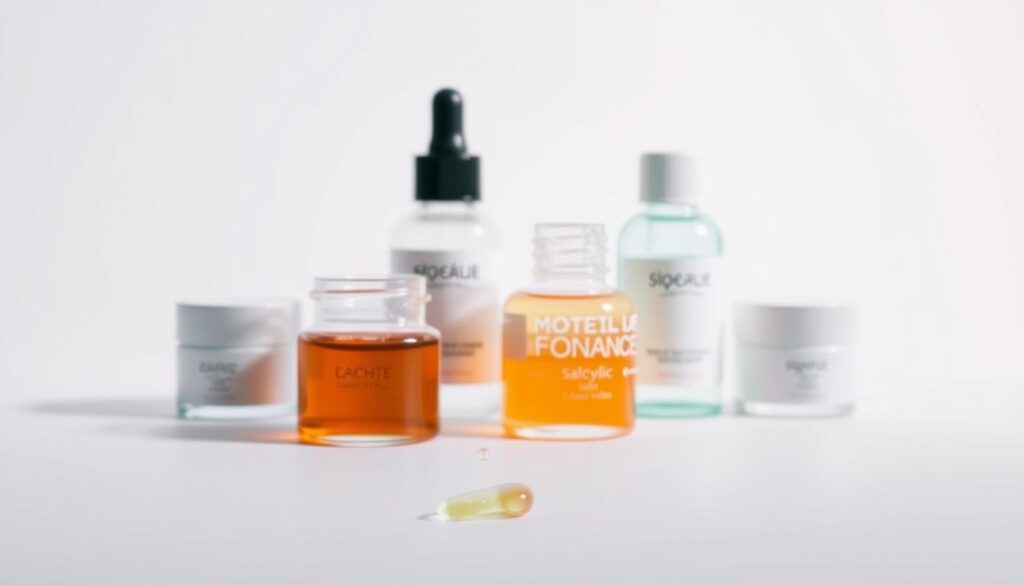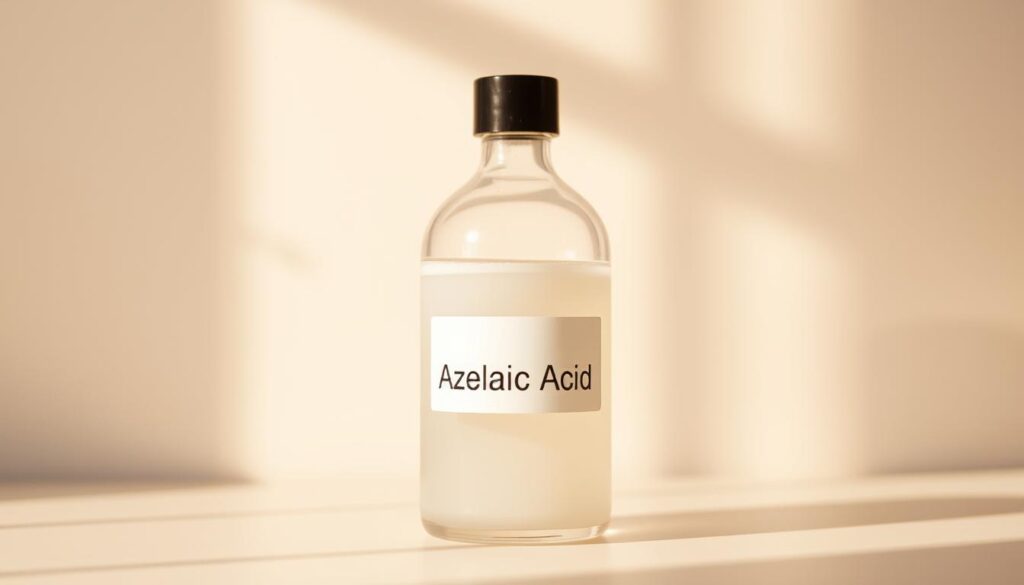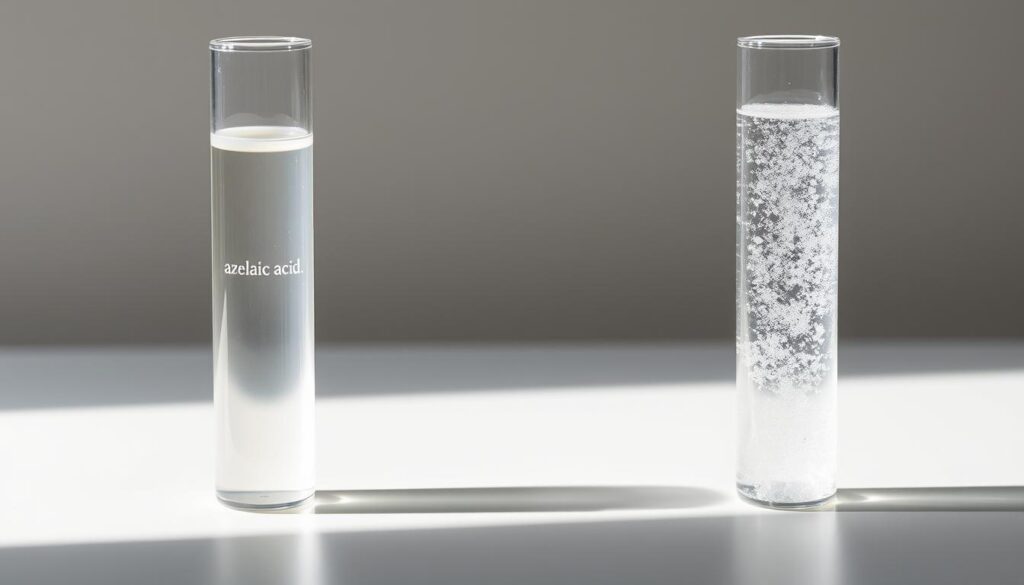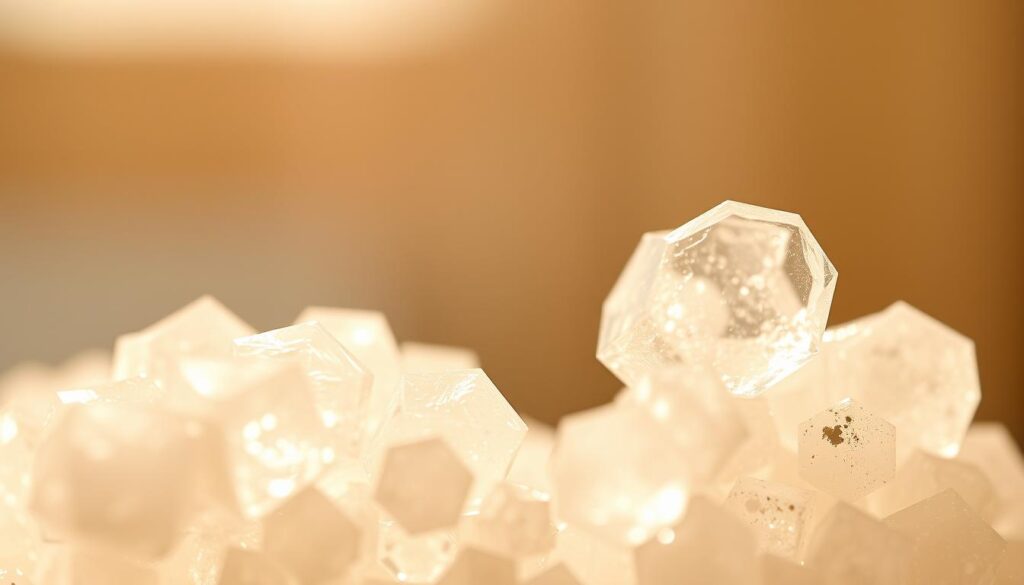At Glowskinhub.com, we believe beauty isn’t just a look—it’s a feeling

Azelaic vs Salicylic Acid: An Overview of These Skincare Acids
When it comes to achieving healthy, glowing Skin, skincare acids are often a crucial part of the routine. Two popular acids that have gained significant attention in recent years are azelaic and salicylic acid. Both are known for their effectiveness in addressing various Skin concerns, including acne treatment and rosacea management.
The debate between azelaic vs salicylic acid centers around their different properties and benefits. Understanding the unique characteristics of each acid is essential to determining which one is best suited for your Skin type and concerns.
Key Takeaways
- Azelaic and salicylic acid are both effective in treating Skin concerns.
- They have different properties and benefits.
- Understanding their unique characteristics is crucial for choosing the right acid.
- Both acids are useful for acne treatment and rosacea management.
- Comparing azelaic vs salicylic acid helps determine the best acid for your Skin type.
Understanding Skincare Acids
Acids play a crucial role in maintaining healthy, glowing Skin. They are a cornerstone in many skincare routines, offering a range of benefits from exfoliation to addressing specific Skin concerns like acne and hyperpigmentation.

The Role of Acids in Skincare Routines
Skincare acids are integral to a well-rounded skincare routine, helping to exfoliate, brighten, and balance the Skin. They come in various forms, each with unique properties that target different Skin issues.
| Type of Acid | Primary Benefit | Common Use |
|---|---|---|
| Alpha Hydroxy Acids (AHAs) | Exfoliation, hydration | Improving Skin texture, reducing fine lines |
| Beta Hydroxy Acids (BHAs) | Deep cleansing, anti-inflammatory | Treating acne, blackheads |
How Acids Work on the Skin
Acids work by penetrating the Skin’s surface, where they can dissolve dead Skin cells, unclog pores, and stimulate collagen production. This process not only improves Skin texture but also helps in managing various Skin conditions.
By understanding how different acids work, individuals can make informed decisions about their skincare routine, choosing products that best address their specific Skin concerns.
What is Azelaic Acid?
Azelaic acid, a dicarboxylic acid, is found naturally in grains such as wheat, rye, and barley. It has been widely used in dermatology for its therapeutic properties.
Natural Sources and Production
Azelaic acid is naturally produced by yeast that lives on normal Skin. It can also be synthesized for commercial use, ensuring a consistent supply for the skincare industry.
Chemical Properties
Azelaic acid possesses antibacterial, anti-inflammatory, and antioxidant properties, making it an effective ingredient against various Skin conditions. Its chemical structure allows it to penetrate the Skin, targeting the source of Skin issues.
Available Concentrations and Formulations
Azelaic acid is available in various concentrations and formulations, including creams, gels, and foams. Common concentrations range from 15% to 20%, with some products offering lower concentrations for sensitive Skin.
| Concentration | Formulation | Use Case |
|---|---|---|
| 15% | Cream/Gel | General skincare, mild conditions |
| 20% | Cream/Gel/Foam | More severe Skin conditions, acne, rosacea |

Understanding the different formulations and concentrations of azelaic acid can help individuals choose the most suitable product for their Skin type and concerns.
What is Salicylic Acid?
With its origins in willow bark, salicylic acid is a key component in many skincare formulations. It is a beta hydroxy acid (BHA) known for its ability to penetrate deep into pores, making it an effective exfoliant.
Origins and Production
Salicylic acid is naturally found in willow bark and wintergreen leaves. While it can be derived from these natural sources, most commercial salicylic acid is synthesized in a laboratory to ensure purity and consistency.
Chemical Characteristics
Salicylic acid is a lipophilic compound, meaning it has an affinity for oils, which allows it to effectively penetrate into the pores of the Skin. Its anti-inflammatory properties also make it beneficial for soothing irritated Skin.
Concentrations and Formulations
Salicylic acid is available in various concentrations and formulations, including cleansers, toners, and spot treatments. Concentrations can range from 0.5% to 2% for over-the-counter products, while higher concentrations may be used in professional chemical peels.
| Product Type | Concentration Range | Benefits |
|---|---|---|
| Cleansers | 0.5% – 2% | Gentle exfoliation, cleansing |
| Toners | 0.5% – 2% | Balancing Skin pH, exfoliating |
| Spot Treatments | 2% | Targeted acne treatment, reducing inflammation |

Azelaic vs Salicylic Acid: An Overview of Their Key Differences
Azelaic and salicylic acid are two popular skincare ingredients that, despite their similarities, have distinct differences in their chemical makeup and how they work on the Skin.
Chemical Structure Comparison
Azelaic acid is a dicarboxylic acid with a distinct chemical structure that allows it to target various Skin concerns. Salicylic acid, on the other hand, is a beta hydroxy acid (BHA) known for its ability to penetrate deep into pores.
The chemical structure of azelaic acid contributes to its anti-inflammatory properties, making it suitable for sensitive Skin. In contrast, salicylic acid’s structure enables it to exfoliate the Skin effectively.
| Characteristics | Azelaic Acid | Salicylic Acid |
|---|---|---|
| Chemical Classification | Dicarboxylic Acid | Beta Hydroxy Acid (BHA) |
| Primary Use | Anti-inflammatory, Antimicrobial | Exfoliation, Pore-clearing |
Mechanism of Action
Azelaic acid works by reducing inflammation and preventing the growth of certain bacteria that can cause acne. Salicylic acid, by contrast, penetrates deep into pores to unclog them and reduce acne.
Absorption and Penetration
The absorption and penetration of these acids into the Skin differ. Azelaic acid is known for its gentle absorption, making it suitable for sensitive Skin types. Salicylic acid, due to its lipophilic nature, penetrates more deeply into the Skin, making it effective for blackheads and whiteheads.

Benefits of Azelaic Acid for Skin
Azelaic acid has emerged as a versatile skincare ingredient, offering numerous benefits for various Skin concerns. Its multifaceted properties make it an effective solution for addressing different Skin issues.
One of the key advantages of azelaic acid is its anti-inflammatory properties. It helps in reducing redness and inflammation, making it beneficial for sensitive Skin and conditions like rosacea.
Anti-inflammatory Properties
Azelaic acid’s anti-inflammatory properties are crucial in calming irritated Skin and reducing the appearance of redness. This makes it an excellent ingredient for those dealing with inflammatory Skin conditions.

Antimicrobial Effects
In addition to its anti-inflammatory properties, azelaic acid also exhibits antimicrobial effects. It helps in controlling the growth of certain bacteria and other microorganisms that can cause acne and other Skin issues.
Hyperpigmentation Treatment
Azelaic acid is also effective in treating hyperpigmentation. It works by inhibiting the production of melanin, the pigment responsible for Skin color, thereby helping to reduce the appearance of dark spots and hyperpigmented areas.
By addressing hyperpigmentation, azelaic acid helps in achieving a more even Skin tone, making it a valuable ingredient for those looking to improve the overall appearance of their Skin.
Benefits of Salicylic Acid for Skin
Salicylic acid offers several benefits that can significantly improve Skin health and appearance. It is a beta hydroxy acid (BHA) that is widely used in skincare products due to its effectiveness in addressing various Skin concerns. Its benefits range from exfoliating the Skin to reducing inflammation.

Exfoliation Properties
One of the primary benefits of salicylic acid is its ability to exfoliate the Skin. It helps remove dead Skin cells from the surface, revealing smoother and brighter Skin. This process also helps to unclog pores, reducing the occurrence of acne and blackheads.
Pore-Clearing Abilities
Salicylic acid is known for its pore-clearing abilities, making it an effective ingredient in products targeting acne and blackheads. By penetrating deep into the pores, it helps to dissolve and remove debris that can cause these Skin issues. Regular use can lead to a significant reduction in pore size and acne severity.
Anti-inflammatory Effects
In addition to its exfoliating and pore-clearing properties, salicylic acid also possesses anti-inflammatory effects. It can help reduce redness and swelling associated with acne and other Skin conditions. This makes it a valuable ingredient for individuals with sensitive Skin or those prone to inflammatory Skin issues.
The combination of exfoliation, pore-clearing, and anti-inflammatory effects makes salicylic acid a versatile and effective skincare ingredient. By incorporating products containing salicylic acid into their routine, individuals can address multiple Skin concerns simultaneously, leading to improved Skin texture and reduced appearance of acne and other issues.
Skin Conditions Treated by Azelaic Acid
Azelaic acid is a versatile skincare ingredient that has been shown to effectively treat various Skin conditions. Its therapeutic properties make it an ideal solution for addressing specific Skin concerns.
Acne Treatment
Azelaic acid is known for its ability to combat acne by reducing the growth of bacteria that can cause breakouts. It also has anti-inflammatory properties, which help to minimize redness and swelling associated with acne.
“Azelaic acid’s dual-action against bacteria and inflammation makes it a valuable treatment for acne-prone Skin,” notes a skincare expert. This is particularly beneficial for individuals who struggle with persistent acne.
Rosacea Management
Azelaic acid is also effective in managing rosacea, a condition characterized by redness, inflammation, and sometimes acne-like symptoms. By reducing inflammation and preventing bacterial growth, azelaic acid helps to alleviate the symptoms of rosacea.
Post-Inflammatory Hyperpigmentation
Furthermore, azelaic acid has been shown to be effective in treating post-inflammatory hyperpigmentation (PIH), a condition where areas of the Skin become darker due to inflammation. Azelaic acid works by inhibiting the production of melanin, thereby reducing the appearance of hyperpigmented areas.
Overall, azelaic acid’s multifaceted benefits make it a valuable ingredient in skincare routines, particularly for those dealing with acne, rosacea, or hyperpigmentation.

Skin Conditions Treated by Salicylic Acid
Salicylic acid is renowned for its efficacy in treating a variety of Skin conditions. Its versatility in addressing dermatological issues makes it a popular ingredient in many skincare products.
Acne and Blackheads
Salicylic acid is particularly effective in treating acne and blackheads due to its ability to penetrate deep into the pores, unclogging them and reducing inflammation. It helps to prevent future breakouts by keeping the pores clear.
Seborrheic Dermatitis
For individuals suffering from seborrheic dermatitis, salicylic acid can help reduce the scaling and inflammation associated with this condition. It works by gently exfoliating the Skin and reducing the buildup of scales.
Psoriasis and Keratosis Pilaris
Salicylic acid is also beneficial for managing psoriasis and keratosis pilaris. It helps to soften and remove scales associated with psoriasis and smooths the rough patches caused by keratosis pilaris.
| Skin Condition | How Salicylic Acid Helps |
|---|---|
| Acne and Blackheads | Unclogs pores, reduces inflammation |
| Seborrheic Dermatitis | Reduces scaling, inflammation |
| Psoriasis and Keratosis Pilaris | Softens and removes scales, smooths rough patches |
By understanding how salicylic acid addresses various Skin conditions, individuals can make informed decisions about incorporating it into their skincare routine.
How to Choose Between Azelaic and Salicylic Acid
The choice between azelaic and salicylic acid depends on several factors, including your Skin type and specific concerns. Understanding these factors is crucial for making an informed decision about your skincare routine.
Skin Type Considerations
Your Skin type plays a significant role in determining which acid is more suitable for you. For instance, if you have sensitive Skin, azelaic acid might be a better option due to its gentle and non-irritating properties. On the other hand, if you have oily Skin with blackheads, salicylic acid’s ability to penetrate deep into pores might be more beneficial.
| Skin Type | Azelaic Acid | Salicylic Acid |
|---|---|---|
| Sensitive | Recommended | Use with caution |
| Oily | Effective for acne | Highly recommended |
| Dry | Gentle, hydrating | May be too harsh |
Specific Skin Concerns
Different acids target different Skin concerns. If your primary concern is hyperpigmentation or rosacea, azelaic acid’s anti-inflammatory properties can be highly beneficial. Conversely, if you’re dealing with acne or blackheads, salicylic acid’s exfoliating properties might be more effective.
Sensitivity Factors
Sensitivity is another critical factor to consider. Azelaic acid is generally well-tolerated, even by sensitive Skin. Salicylic acid, while effective, can sometimes cause irritation, especially at higher concentrations. If you’re new to using skincare acids, starting with a lower concentration and gradually increasing as your Skin becomes more tolerant is advisable.
By considering your Skin type, specific concerns, and sensitivity factors, you can make a more informed decision about whether azelaic or salicylic acid is right for you.
Incorporating These Acids Into Your Skincare Routine
To maximize the benefits of azelaic and salicylic acid, it’s essential to understand how to integrate them effectively into your daily skincare regimen. Both acids offer unique benefits, and their effectiveness can be enhanced when used correctly.
Time of Application
The timing of applying azelaic and salicylic acid can impact their efficacy. Azelaic acid can be used both in the morning and evening, as it helps in reducing inflammation and combating bacteria that cause acne. Salicylic acid, being a exfoliant, is typically more effective when used in the evening, as it helps in removing dead Skin cells and unclogging pores.
Complementary Products
To enhance the benefits of these acids, it’s crucial to pair them with complementary products. For azelaic acid, using it with moisturizers can help mitigate any potential dryness or irritation. Salicylic acid, on the other hand, works well with clay-based masks to deep clean pores.
Products to Avoid Using Together
Certain products can interact negatively with azelaic and salicylic acid. For instance, using other exfoliating products or products containing alcohol with salicylic acid can lead to excessive dryness and irritation. Similarly, combining azelaic acid with harsh products can exacerbate sensitivity.
By understanding how to incorporate azelaic and salicylic acid into your skincare routine, you can maximize their benefits and achieve healthier, more radiant Skin.
Potential Side Effects and Precautions
While azelaic and salicylic acid are beneficial for various Skin concerns, it’s crucial to be aware of their potential side effects. Both acids are generally considered safe when used correctly, but they can cause adverse reactions in some individuals.
Azelaic Acid Side Effects
Azelaic acid is typically well-tolerated, but it can cause mild side effects such as itching, redness, or dryness, especially during the initial treatment phase. These effects are usually temporary and may subside as your Skin becomes more tolerant.
Salicylic Acid Side Effects
Salicylic acid can cause side effects like dryness, irritation, or redness, particularly if used in high concentrations or too frequently. It’s also possible for some individuals to experience an allergic reaction, which can manifest as hives, itching, or swelling.
Who Should Avoid These Acids
Certain individuals should exercise caution or avoid these acids altogether. For instance, those with sensitive Skin may need to start with lower concentrations and gradually increase as their Skin becomes more tolerant. Pregnant or breastfeeding women should consult their healthcare provider before using products containing salicylic acid, as high concentrations may pose risks.
| Acid | Common Side Effects | Precautions |
|---|---|---|
| Azelaic Acid | Itching, redness, dryness | Start with lower concentrations for sensitive Skin |
| Salicylic Acid | Dryness, irritation, allergic reactions | Avoid during pregnancy/breastfeeding without consulting a healthcare provider |
Conclusion
Understanding the differences between azelaic and salicylic acid is crucial for making informed decisions about your skincare routine. Both acids offer unique benefits, from treating acne and hyperpigmentation to exfoliating and clearing pores.
When deciding between azelaic vs salicylic acid, consider your specific Skin concerns and type. Azelaic acid is ideal for sensitive Skin, offering anti-inflammatory and antimicrobial properties. Salicylic acid, on the other hand, is better suited for those with oily Skin or blackheads, due to its exfoliating and pore-clearing abilities.
Incorporating the right skincare acids into your routine can significantly improve Skin health. By choosing the appropriate acid for your Skin type and concerns, you can achieve a clearer, healthier complexion. Whether you opt for azelaic or salicylic acid, the key is to start with a lower concentration and gradually increase as your Skin becomes more tolerant.





